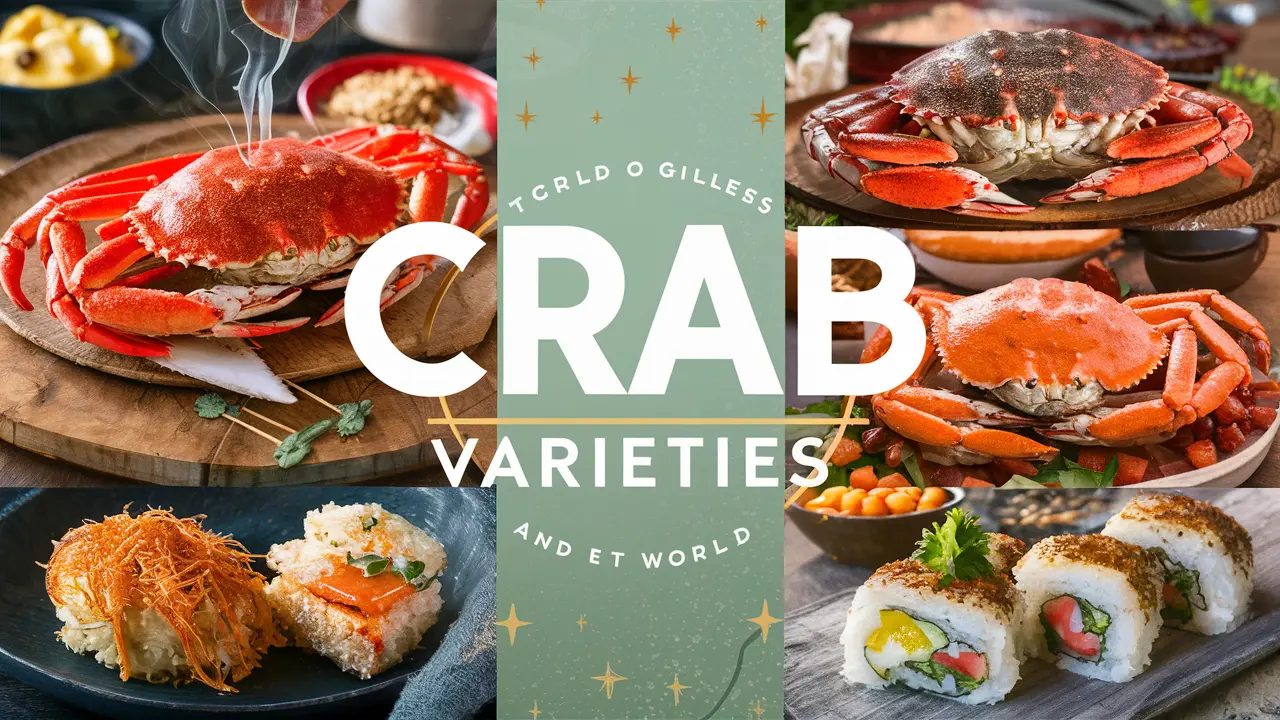Introduction to the World of Crabs
Because of their rich flavor and delicious flesh, crabs are highly regarded in the culinary world. There are many types of crabs to eat, including the sweet Dungeness and the succulent King Crab, which offer a range of flavors and textures to satisfy different palates.
Crabs are embedded in the culinary traditions of many coastal communities, and their popularity extends far beyond, gracing tables worldwide with their presence.
The environmental factors, diet, and even stage in the crab’s life cycle contribute significantly to the unique flavors presented by each species.
Varieties of Crab Worth Savoring
Connoisseurs relish a multitude of crab types, each heralded for distinct qualities. Blue crabs, often found in the Chesapeake Bay, are celebrated for their delicate, sweet meat, making them a favorite for traditional crab cakes. King Crabs, giants of the crab world, boast a firm and savory meat highly desired by gourmands.
Snow crabs, with their long, graceful legs, offer a subtly sweet meat that is delicious and adventureful in texture.
Finally, the Dungeness crab, predominantly harvested from the cool eelgrass beds of the Pacific Northwest, provides a lovely and tender flesh that has become synonymous with gourmet seafood.
Geographical Influence on Crab Taste and Texture
It’s no secret that geographical factors profoundly influence the flavor and texture of crab. Crabs from different waters worldwide offer a spectrum of taste experiences due to their habitats’ varying salinity, minerals, and temperatures.
The unique environment where a crab spends its life leads to distinctive flavors; where some crabs may have a salty sweetness, while others present a clean, buttery taste.
These subtle differences make regional crab dishes such a rich and immersive experience, reflecting the essence of their local waters.
Seasonal Variations in Crab Harvesting
The calendar year is dotted with seasons that mark the best times to enjoy different types of crab. Understanding these cycles is crucial for both culinary excellence and environmental responsibility.
For example, the Alaskan King Crab season is short, usually in the fall, making it an anticipated event for seafood lovers.
In contrast, Blue Crabs are best enjoyed in the warmer months when they become plump and flavorful after shedding their shells. Consumers can enjoy the freshest and most succulent crabs during these seasonal peaks.
The Art of Preparing and Cooking Crab
How a crab is prepared can profoundly influence its flavor, texture, and overall dining experience. Boiling and steaming are among the most commonly deployed cooking methods, known for retaining the moisture and delicate taste of the crab meat.
Conversely, grilling can imbue the shellfish with a smoky, unique, and irresistible flavor. The freshness of the crab is another vital aspect; it is always best to prepare it soon after it’s been caught, ensuring that none of its natural flavors are lost.
From cleaning to cracking, every step in the preparation process is as important as the cooking itself, each inching toward the perfect crab dish.
Pairing Crabs with the Right Condiments and Wines
The delicate crab flavors deserve thoughtful pairings that enhance rather than overpower them. Light butter sauces and lemon wedges are classic accompaniments that respect the crab’s natural flavor profile.
For those desiring a bit more zest, a tangy remoulade or a spicy cocktail sauce can add flavor to each bite. Regarding wine pairings, a crisp, minerally white wine seems to be a match made in heaven for crab dishes.
An exquisite eating experience is completed with chilled wines like Pinot Grigio or Chardonnay, which have refreshing undertones that balance the sweetness of the crab.
Health Benefits of Including Crab in Your Diet
Incorporating crab into one’s diet is a treat for the taste buds and a boon for health. Crab meat is a low-fat, high-protein seafood option filled with omega-3 fatty acids, known for their cardiovascular benefits.
It is also a source of vitamins and minerals, such as vitamin B12 and selenium, which play critical roles in maintaining good health and immunity. It makes crab an excellent option for those looking to enjoy a nutritious meal without sacrificing flavor.
Understanding the Supply Chain of Crabs
The pathway from the watery depths to the dining table is intricate for crabs. This path requires responsible management at each step to ensure the stability of ecosystems and the jobs of those who rely on them.
Consumers participate in a more significant movement towards a more environmentally sound future by favoring crabs from fisheries that practice sustainable harvesting and maintain ethical supply chains.
Transparent practices within the supply chain allow for a better understanding of the product’s journey and empower consumer decisions that propel positive change for oceans and the industries they support.
The Future of Crabbing: Innovations and Challenges
As the demand for crabs continues to grow, so does the need for innovation in the methods used to catch and sustain crab populations. Emerging technologies in the marine industry aim to reduce bycatch, improve the precision of crabbing techniques, and monitor crab habitats more effectively.
However, these advancements must be balanced against the challenge of preserving marine biodiversity, ensuring that crab populations are not overexploited.
With the continual threat of climate change and its impact on marine environments, it’s more important than ever to find a sustainable approach to crabbing, allowing us to enjoy this resource while protecting the delicate balance of the ocean’s ecosystems.
Exploring Crab Cuisine Around the World
Across the globe, cooks and chefs are reimagining the place of crab in culinary tradition. In Asia, crab is often at the center of spicy and flavorful creations, while in Europe, it can be found in more understated yet elegant dishes.
The United States has signature offerings, from New England’s crab-laden soups to the South’s spicy crab boils. Each dish tells a story of the people, the land, and the waters where the crabs were sourced.
The cultural heritage bound in crab-based dishes deepens the understanding and appreciation of this versatile seafood, inviting epicures to embark on a journey through crab cuisine’s diverse and sumptuous world.



